Xigmatek NRP-HC1001 and NRP-HC1201 Power Supplies
by Christoph Katzer on April 13, 2008 12:00 PM EST- Posted in
- Cases/Cooling/PSUs
Efficiency
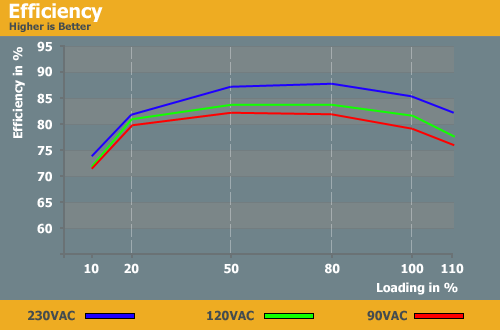
We are including two different graphics of efficiency. The first shows the efficiency at the load percentages and the second shows the efficiency at the different wattage outputs. The second one gives users a better comparison to other power supplies. If you know the amount of power your system requires, you can look up that load in the table below and see what efficiency the power supplies will provide.
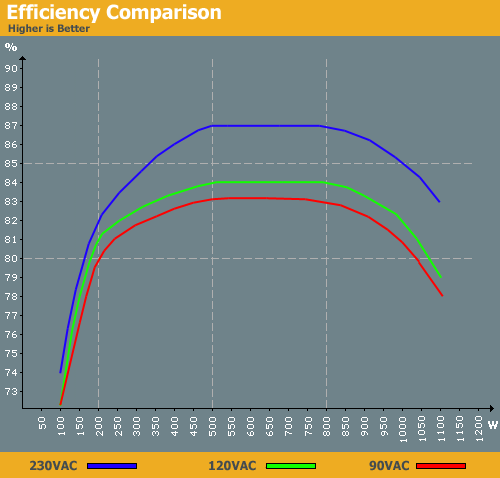
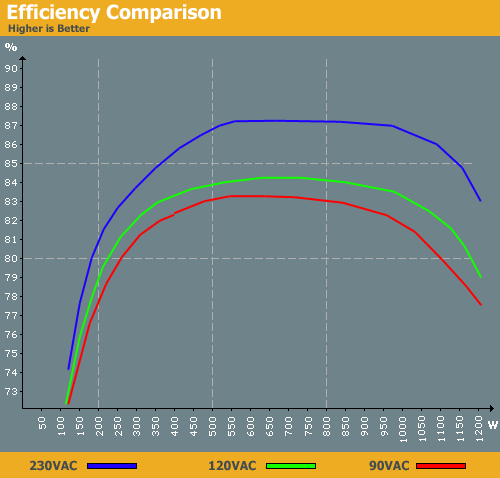
Not long ago a power supply company came to us and urged us to use the 80Plus table to load the power supplies instead of the ATX norm. The 80Plus table only looks at 20%, 50% and 100% of load which is quite narrow minded in our opinion and not really useful for our range of tests at all. An important factor is left out and that it where most system run, most of the time: around 10% of their maximum output in idle mode (at least on larger PSUs). Even though both calculation tables both look similar, we will still stick to the ATX norm which just makes more sense.
The efficiency of these two models is very good and the graphs show that users with a huge power usage will benefit most in energy savings. From 500W upwards, power output on these two units reaches an efficiency of 87% at 230VAC. In the US and other locations that use 115VAC, these units still run with a maximum efficiency of up to 84% over a large range of load. For users that run at less than 500W of load (most of the time), these power supplies won’t make much economic sense since you can buy a unit with a lower output rating and save a lot of money.
Power Factor Correction
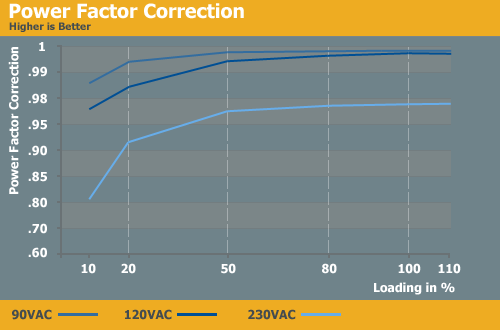
As always the power factor correction is much better with lower input voltage. This unit covers more than .99 (PFC) even with the lower loads. People in Europe need to be happy with an average result of .98 (PFC) tops.
Fan Speed and Acoustics
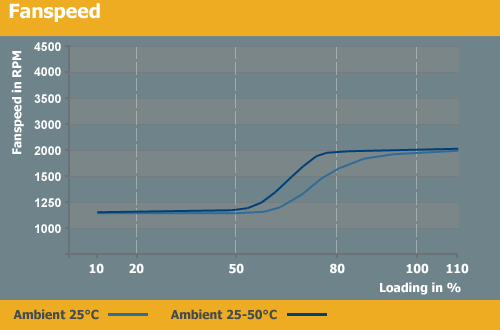

Both of the units are clearly audible while running even at the lowest load, or in fact with no load at all. The fan runs with a minimum of 1200RPM, which should not be necessary as a minimum. The noise levels therefore start at 21dB(A), but listening to the fan it seems much louder than that. With increased loads, the fan quickly starts to spin faster past the 50% load mark, and beyond 650W it's quite loud. The highest result we measured was 33dB(A) with a fan speed of 2000RPM. That's still a reasonable result but again we have to add that the sound coming from the power supply seems much louder than the 33dB(A) we’ve heard before from other units.










20 Comments
View All Comments
HOOfan 1 - Monday, April 14, 2008 - link
well read the article then. They state it is made by CWT...just like the Thermaltake Toughpower, the Xclio Greatpower, The Corsair HX1000, The Gigabyte Odins and several others.C'DaleRider - Monday, April 14, 2008 - link
[quote]We have heard from other companies that the basic CWT design is practically unusable as there are too many flaws inherent in the design.[/quote]So, you've take some rumor, FUD, innuendo, whatever from one competitor about another without naming the source, investigating anything, pointing out the specific design flaws....yet print that "claim" as gospel?
Your credibility has just taken another nosedive. Or you've become nothing more than a paid mouthpiece for other companies....maybe like PCP&C, because that comment above sure does sound just like the FUD advertisements PCP&C ran back in 2003 against "unspecified" power supply sellers.
The ads were aimed at Antec even though the example PSU (PCP&C named the PSU as a "550W" but left the brand as a blank, but we all know who had a popular 550W back in 2003 when those ads were popping up in certain magazines) was clearly not a CWT build because they had an example unit shown with the case opened.
In fact, the PSU from that old ad looked like a Thermaltake 550W but with a unpainted casing rather than the black casing that Thermaltake used at that time. If you've got any Maximum PC mags from 2003 you can find easily the ads.
It always suspected that PC P&C was trying to point fingers at Antec and this review pretty much verifies that suspicions were correct in this guess. The sad thing is that if you take one of those CWT built Antecs and load and scope it, one will find that it was a competent unit with all the power it promised at better than 3% regulation and decent ripple. Had CWT not been hobbled with using the caps that Antec specifically asked for (Fuhjyyus), that particular build would be remembered very differently.
whatthehey - Monday, April 14, 2008 - link
Seriously, shut the hell up and RTFA! They comment about some CWT builds having issues, but then they also point out that the overall performance of the latest CWT designs seems very good... as this review shows. I love how people get their pants in a bind over one little sentence/paragraph in an article."OMG, you talked about how people in the past said CWT sucks, but you're still reviewing them favorably! You're bought out by the competition AND by the company whose power supply you're reviewing! In fact, Intel and NVIDIA own you and pay for everything you write! I'm going to go read HardOCP instead, since they're only bought out by AMD!"
Give it a rest already. The only credibility taking a nosedive (again) is related to average reading comprehension and apparently already biased opinion. Hell, go back to reading Maximum PC and let the people that actually know hardware do their thing here.
C'DaleRider - Monday, April 14, 2008 - link
I love people who comment about things they know nothing about.In reality, CWT has made no changes to their designs....not a single thing. Of course, you might know this if you managed to ever read previous reviews of CWT-built power supplies from a few years ago...but who are you to bother to read and get any facts, but instead attack and rant about something you know nothing about.
The fact of the matter is Anandtech, and this particular reviewer, chose to publish a condemnation of CWT designs of their power supplies, then supposes there has been an update to their designs. But nowhere does the reviewer ever point out the fatal flaws, the redesigns, or any other fact.....just innuendo and FUD from a competitor....and using that FUD as fact.
That'd be akin to someone printing that whatthehey was a pedophile years ago but is much better now, or that whatthehey was previously unable to hold down a productive job because of rumors of drug use, but is now a drug-free recovering addict.
Just because someone says something, doesn't mean it's true, does it? In the case of this power supply review, AT has really opened themselves up to some critical looking at, maybe by a company that has its reputation called into question. It's called libel.....
JarredWalton - Monday, April 14, 2008 - link
Keep the flames elsewhere, people.I have edited the text slightly in this paragraph to better reflect the intended meaning. Acknowledging that competitors are bad-mouthing a design isn't the same thing as saying the competitors are telling the truth. While I'm sure you'd all love a conspiracy theory, Christoph didn't include that statement to make CWT look bad. (Libel? Please.)
If you look around, you can find information on the Internet that implies CWT is a terrible source for PSUs. Like many larger companies, they have certainly had some bad designs, but the current high-end offerings are very good. (Not so sure I'd say the same thing for many of the 300-450W CWT offerings, though....)
As an ODM, CWT makes PSUs according to the specifications they receive; if a company wants to use less expensive components in order to keep price down, they will comply. In fact, it's safe to say that if you take any basic PSU design and replace all the components with inexpensive, lower rated parts, efficiency and quality will quickly take a nosedive.
Has anything changed with the basic build of CWT PSUs? I couldn't say; I've never dismantled an older CWT unit or a new design. Christoph has, though, so if he wants to imply that some changes were made to improve quality, I'm willing to trust him. (I'd tell him to respond, but he's apparently traveling for the next couple of weeks.)
Kanchenjunga - Monday, April 14, 2008 - link
The reviewer makes a claim about design flaws (without stating what those are) and then assumes that the flaws must have been fixed. It's clear from that alone that he has no idea what these design flaws are supposed to be or he would have told us just what it is that's been fixed.He's trying to market himself as having some kind of insight or inside info regarding CWT's "basic design" and fails at it.
HOOfan 1 - Monday, April 14, 2008 - link
I was also a bit suprised at the opening line of the new OCZ ElitXstream"One look inside tells us what ODM is at the heart of the design, which dimmed our expectations a bit"
Why was that? Impervio has certainly have better quality in the recent past than OCZ's other OEM, FSP.
Carnildo - Monday, April 14, 2008 - link
You say they make a 1500-watt power supply? Does it have a three-phase plug, is it better than 90% efficient at full load, or are they simply assuming that nobody will ever use it at full load? US domestic circuits are usually rated at 15 amps, which means that at 110 volts, the line can only deliver 1650 watts.Heidfirst - Monday, April 14, 2008 - link
UK domestic circuits can handle over 3000 watts ...HOOfan 1 - Monday, April 14, 2008 - link
Who pray tell said that.Come come now, if those companies want to fling mud then at least their identities should be exposed
"Seems like someone is spreading FUD, possibly while high, PC Power and Cooling I'm looking at you"